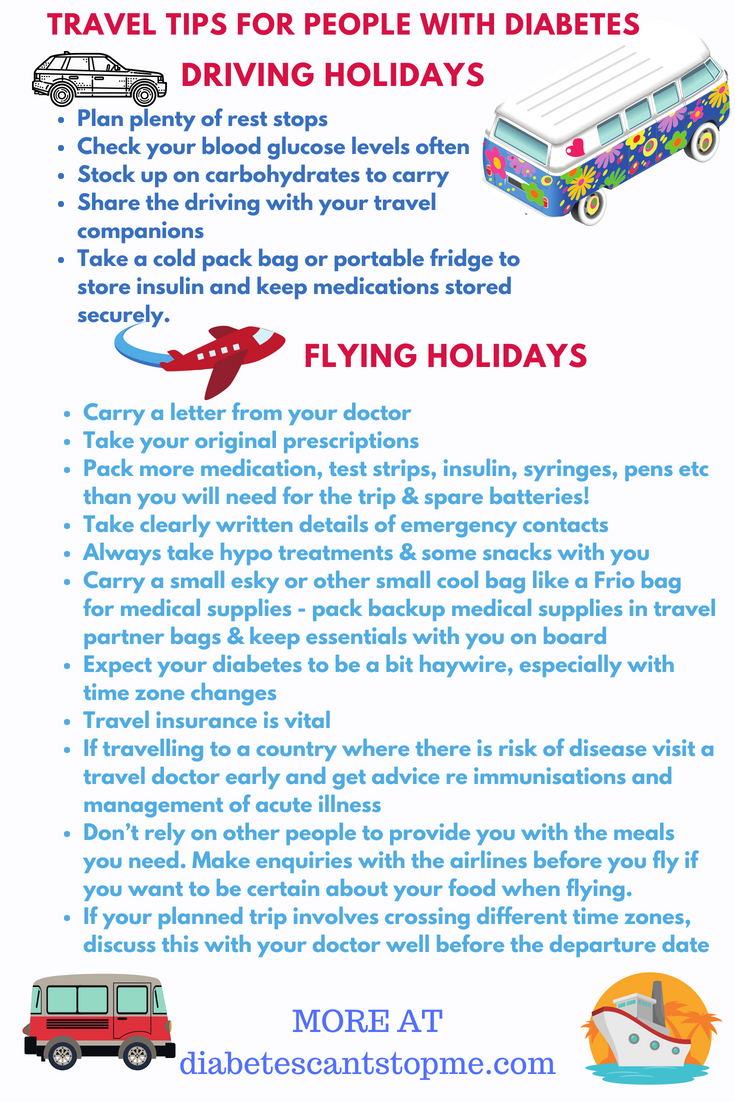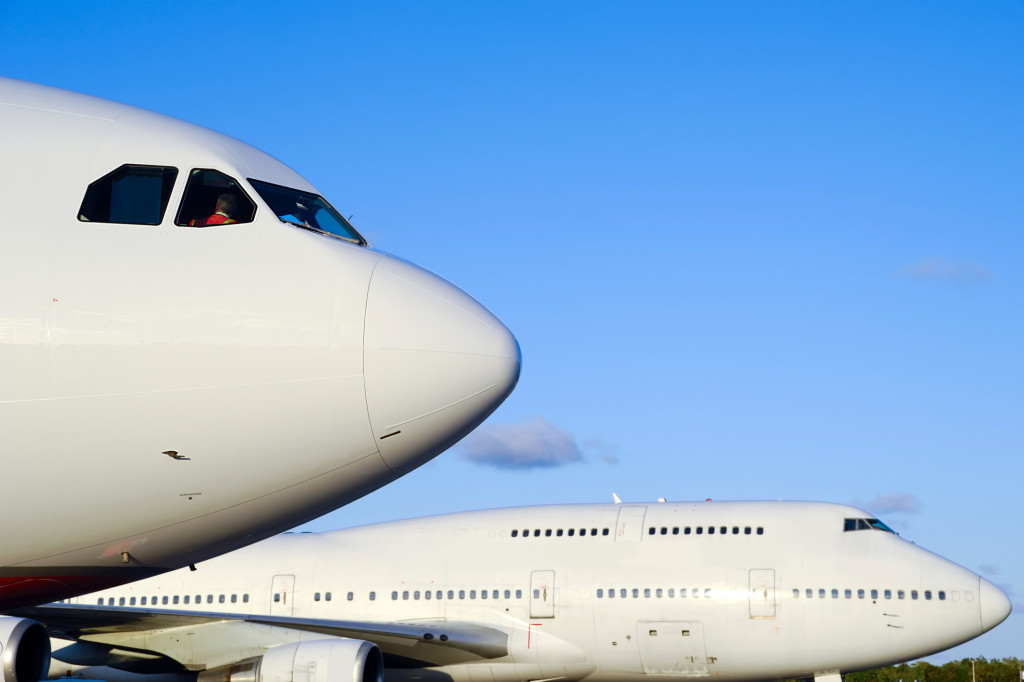
If you have diabetes you will understand the anxiety that can arise when planning a trip away from home or out of your usual routine. Many people worry about how they will manage their diabetes in an environment that is unpredictable.
Some of these concerns include:
- How will you get meals that you can eat, when you need them?
- How will you manage time changes?
- How will you get through airport security?
- Will the weather impact on your blood glucose levels?
- And how about keeping insulin and medications at the right temperature?
These and many other questions can run through your mind when thinking about travelling with diabetes. If you have not had diabetes for long and/or have never travelled since getting diabetes, these concerns can even prevent you from going away.
Having diabetes doesn't mean your travelling days are over!
Like many other situations in life with diabetes, to make sure you have safe, healthy and enjoyable trip it is important to plan ahead and consider all aspects of your journey such as weather, time zones, length of transit time, access to meals, the amount of activity you will be undertaking and potential adjustment to medications and insulin.
Consider how much medication, insulin, blood glucose monitoring supplies, batteries and so on and making sure you have more than enough, is also critical. Many people with diabetes travel across the world.
Driving holidays
If travelling locally and you are driving:
- Plan plenty of rest stops, opportunities to check your blood glucose levels and stock up on carbohydrates.
- Don’t drive long distances without keeping tabs on what is happening with your blood glucose.
- Share the driving with your travelling companions if possible.
- If travelling to tropical or hot regions, be aware that some people find their insulin works faster under these conditions.
- Travel in general can play havoc with your blood glucose, so keeping a close eye on it helps to manage and prevent problems.
- Take a cold pack bag or portable fridge to store insulin and keep medications stored securely.
- Enjoy the drive!
Flying
Carry a letter from your doctor – GP and/or Endocrinologist. This should include your full name, address and date of birth, that you have type 1 or type 2 diabetes and then state all the medications, insulin delivery devices (syringes, insulin pens or pumps) you use; as well as the blood glucose monitoring equipment you use, and stating that you must be allowed to carry these with you at all times. Make several copies of this letter and if travelling with other people, get them to carry copies. Keep a copy with someone at home who can get this to you if needed.
Take your original prescriptions with your name and address details, as well as prescribing doctor and carry insulin and medications in their full packaging with these details on them. Keep these with the letters.
How much to take - Always work out how long you are away for and how many doses of insulin, medication, number of blood glucose checks per day you will need to do, on a day when you might do the most. Then pack more medication, test strips, insulin, syringes, pens and other diabetes equipment than you will need for the trip. If possible, pack a spare blood glucose meter in case of loss or damage. Also pack spare batteries for your blood glucose meter and insulin pump.
If you use an insulin pump always take a back up option – syringes or pen with needles and a short and long acting insulin. Work out with your doctor, what dose of insulin to take if the worst should happen and your insulin pump breaks down. Have a plan!
Take clearly written details of emergency contacts plus your National Diabetes Services Scheme (NDSS) card and Medicare Card.
Customs - if travelling overseas remember that customs regulations vary from country to country, so it’s recommended that if concerned, you contact the Australian Embassy of the country you’re visiting before travelling to chat about your medical needs and entry to the country.
Always take hypo treatments with you - carry some form of easily absorbed carbohydrate such as juice cartons; glucose tablets/gels; or lollies with you. Pack some in your suitcase, some in your carry on bag and keep some on your person, such as in your handbag or bum bag. This way you have something with you in an emergency and if you get separated from your luggage. If travelling with someone, make sure they know about your diabetes and that they also carry hypo treatment. It may even be a good idea to carry a glucagon pen in your medical supplies, even if you have never needed this before.
Stock up on snacks - also carry other food with you, fruit, crackers and snack foods, so you have some follow up carbohydrate and access to food for snacks to prevent hypos – don’t rely on airline foods and access to foods when transiting through airports can be difficult.
Sharps – any sharps - pen needles, blood glucose monitors, lancets; and medications, should be stored in hand luggage according to manufacturer’s directions, preferably in a clear, sealable plastic bag that is available for security inspection. You can also take a small approved sharps container for used lancets and syringes.
Storing insulin - if flying don't place insulin in your regular luggage, as the plane's hold is not temperature controlled and luggage may be damaged or lost. You may even choose to carry a small esky or other small bag like a frio bag - which houses all of your medical supplies and letters making it easy to access when needed. This can include a small first aid kit with items such as paracetamol and antiseptic cream in case of minor illness or injury.
Insulin pumps should be fine to go through all security and screening. If concerned check with your pump manufacturer. You may find some staff at airports more touchy about these than others. Your best bet is to calmly proceed through the screening points and if asked, show the staff where the pump is located for their inspection. However at no time should it be requested that the insulin pump be detached, taken apart or the batteries be removed. You have the right to keep this on you connected at all times. When it comes to CGM and all of the other tech now available - check with the manufacturer as to x-ray requirements and how to handle this.
Identification Wear some form of identification that says you have diabetes – it will make your life a lot easier and safer!
Expect your control to be a little haywire! Be aware that the excitement and stress of travel and holidays can affect your blood glucose levels, so you may need to check your BGLs more often. These may be higher or lower than usual and may swing around more. Don’t stress about levels that are a little out of whack – this will not be a problem in the long run, it is a short term situation and as long as you feel ok and are safe, when in transit it is better to set a slightly higher target for your BGL’s. You can get advice from your doctor or diabetes educator about this prior to travel.
Changes to time zones - If your planned trip involves crossing different time zones, discuss this with your doctor well before the departure date - he/she can advise you on any changes to your individual routine. It may be easier to keep to your usual routines while travelling, then adjust on arrival. For example if on an insulin pump, don’t change your basal rates until you have settled in the country you are visiting.
Meals - When booking your flights, you can tell the airline that you have diabetes and order a “diabetic meal”. However, many of these "diabetic meals" are low in carbohydrate and so a standard meal may be more appropriate. You may also find these more interesting! Making sure you have your own snacks with you is helpful. Don’t rely on other people to provide you with the meals you need. Make enquiries with the airlines before you fly if you want to be certain about your food when flying.
Immunisations - If travelling to a country where there is risk of disease visit a travel doctor early and get advice re immunisations and management of acute illness in particular diarrhoea and/or vomiting. Useful websites include www.health.gov.au.
Travel insurance is vital – you need to make sure it covers people with diabetes. The Australian government has arrangements with some countries providing benefits similar to Medicare if needed. Remember to take your Medicare card with you. For more information, call Medicare Australia on 132 011 or visit their website. Also if travelling overseas you should register with the Smart Traveller Site.
Arrival! Once you get to your destination, the changes in activity (more or less activity than usual), routines, food and stress/excitement, may affect your blood glucose levels. Food options may differ as well. If you're going to a different country, doing some research beforehand will help you find out what foods will be available to you. Always be careful with food and drink choices, particularly in developing countries where food hygiene may not be optimal. In countries where water is an issue always boil your water and do not use ice cubes or have fresh salads which may have been washed in water.
Replacing lost supplies. If the worst happens and your luggage and supplies are lost in transit, the best thing to do is attend a major hospital's emergency room which should be able to supply enough to get you through. Alternatively you can phone the diabetes organisation where you are and ask someone to explain how you obtain diabetes supplies in their state/country.

